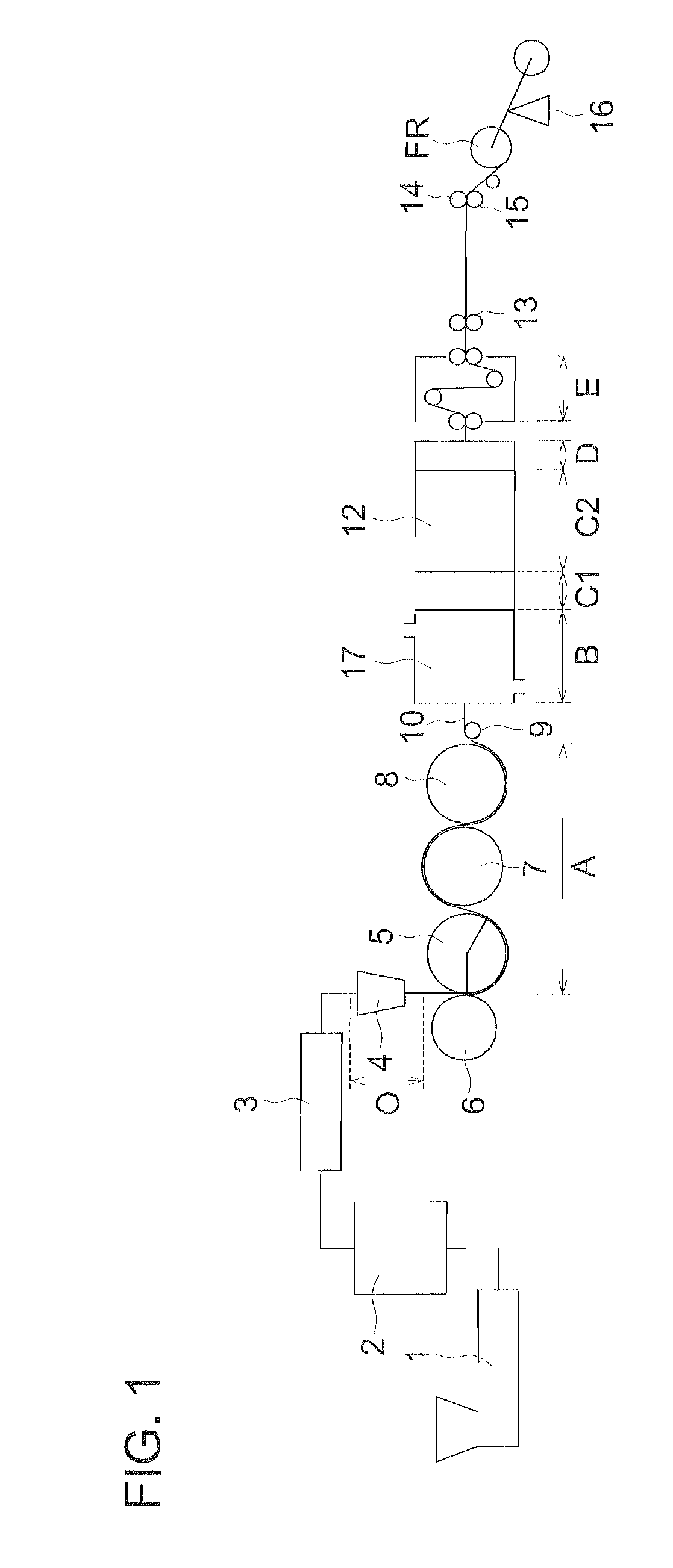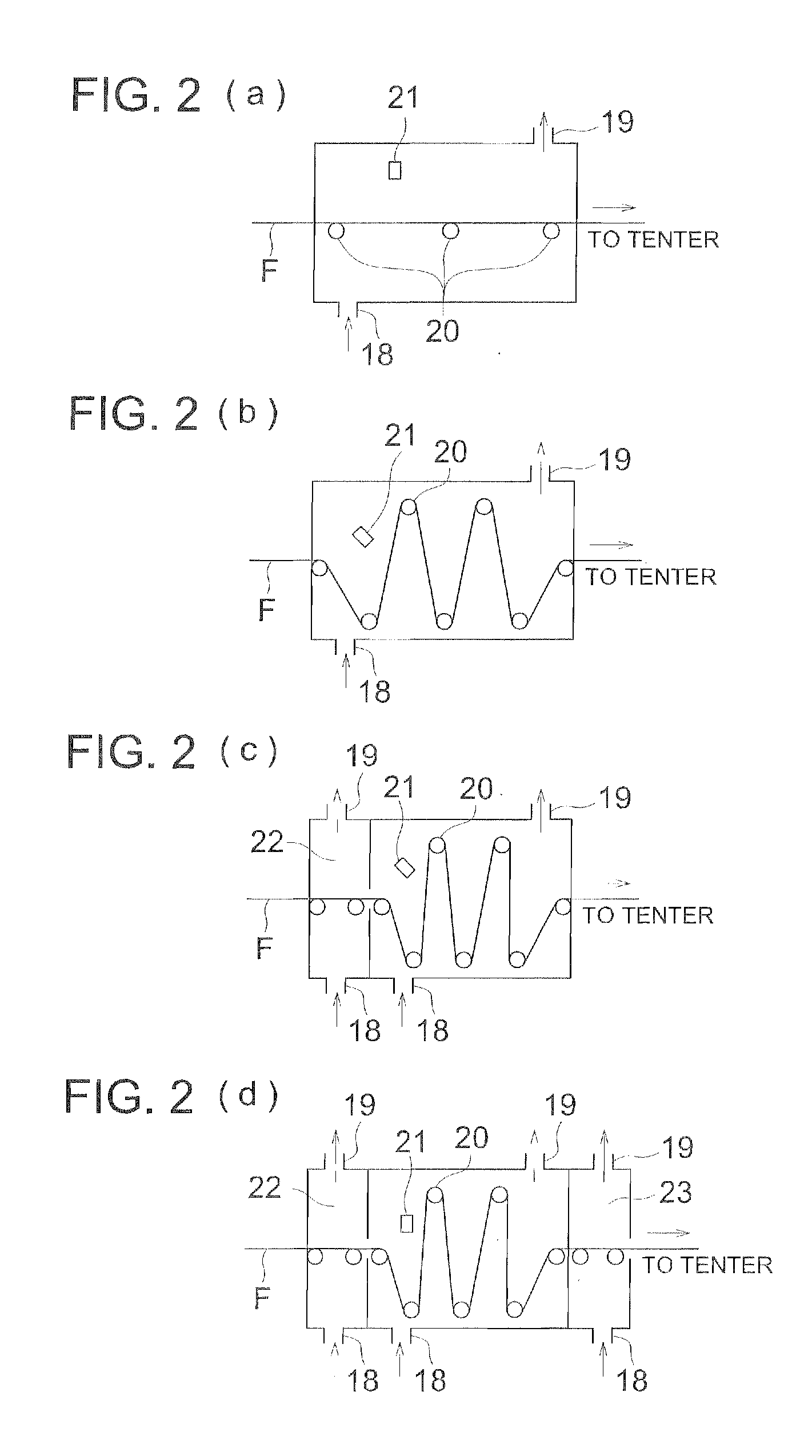Retardation film, method for producing retardation film, polarizing plate and liquid crystal display
a technology of retardation film and polarizing plate, which is applied in the direction of instruments, optical elements, transportation and packaging, etc., can solve the problems of remarkable lowering of contrast, dimensional stability, and film not always suitable, so as to improve light leakage and dimensional stability, and raise front-view contrast
- Summary
- Abstract
- Description
- Claims
- Application Information
AI Technical Summary
Benefits of technology
Problems solved by technology
Method used
Image
Examples
example 1
Measurement of Glass Transition Temperature Tg of Film
[0294]Ten milligram of film sample was heated from −40° C. to 200° C. at a temperature raising rate of 20° C. / minute using a DSC instrument DSC220, manufactured by Seiko Instruments Inc., for obtaining an endothermic curve. Tangent lines were drawn after and before the inflection point of thus obtained endothermic curve and the crossing point of them is defined as the glass transition temperature Tg.
[0295]In the frying apparatus shown in FIG. 2, three non-contact type surface thermometers, Infrared Thermometer IT 2-80, manufactured by Keyence Corp., were arranged in the width direction of the film and the surface temperature of film was measured and the average of the measured values was defined as the temperature of the film.
>
(Preparation of Cellulose Ester Film)
(Materials to be Used)
[0296]C-1. Cellulose acetate propionate: Acetyl group
[0297]substitution degree=1.9, propionyl group substitution
[0298]degree=0.7, molecular weight ...
example 2
[0324]Retardation Films 17 to 27 were prepared in the same manner as in Example 1 except that the holding time in Step B was varied and the luminance was measured from the normal line direction in the same manner as in Example 1 for evaluating the front-view contrast.
[0325]The results of the evaluations are listed in Table 2.
TABLE 2Kind ofGlassHoldingRetar-thermo-transitionThermaltime indationplastictemperaturehysteresisFilm temperature (° C.)Step BRoRtRe-filmresin filmTg (° C.)patternStep AStep BStep C(sec.)(nm)(nm)Contrastmarks17*1143FIG. 3(a)90165140135145700Inv.18*1143FIG. 3(a)901651401035145750Inv.19*1143FIG. 3(a)901651402035145750Inv.20*1143FIG. 3(a)901651404035145750Inv.21*1143FIG. 3(a)901651405035145750Inv.22*1143FIG. 3(a)9016514010035145750Inv.23*1143FIG. 3(a)9016514030030160700Inv.24*1143FIG. 3(b)901651404030140680Inv.25*1143FIG. 3(b)901651403035145680Inv.26*1143FIG. 3(d)901301352035110520Comp.27*1143FIG. 3(d)901301354035115530Comp.*1: Cellulose ester type resin, Inv.: Inv...
example 3
[0327]Retardation film were prepared in the same manner as Examples 1 and 2 except that the tenter stretching apparatus was changed to that capable of independently varying the holding length (the distance from the beginning position to the end position of the holding) on right and left side, respectively, and the front-view contrast of the displays using thus obtained retardation films were determined by measuring the luminance from the normal line direction of the displaying face in the same manner as in Examples 1 and 2. It was understood that the retardation films of the invention improve the front-view contrast in the same or more degree compared with the retardation film of the invention obtained in Examples 1 and 2.
PUM
| Property | Measurement | Unit |
|---|---|---|
| thickness | aaaaa | aaaaa |
| twist angle | aaaaa | aaaaa |
| twist angle | aaaaa | aaaaa |
Abstract
Description
Claims
Application Information
 Login to View More
Login to View More - R&D
- Intellectual Property
- Life Sciences
- Materials
- Tech Scout
- Unparalleled Data Quality
- Higher Quality Content
- 60% Fewer Hallucinations
Browse by: Latest US Patents, China's latest patents, Technical Efficacy Thesaurus, Application Domain, Technology Topic, Popular Technical Reports.
© 2025 PatSnap. All rights reserved.Legal|Privacy policy|Modern Slavery Act Transparency Statement|Sitemap|About US| Contact US: help@patsnap.com



